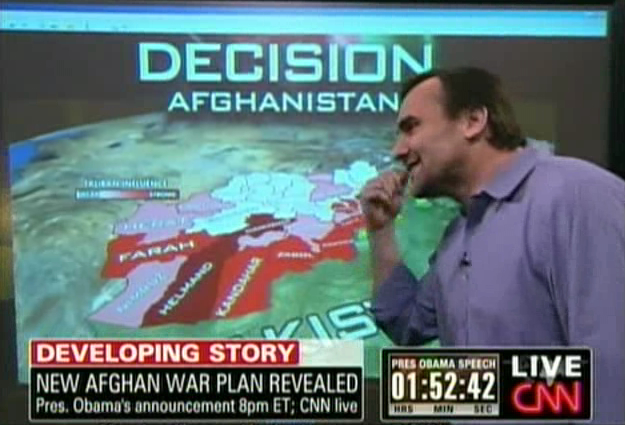TSR: "We took a very, very small bite of a very big apple. There's simply not enough troops here."
December 01, 2009

Length: 4:09
LARGE (48.3 MB) ----- SMALL (5.0 MB)
Michael joins John King at the Magic Wall to explain where US troops are, where we need more people, and who is in power on both the Afghan and Pakistan sides of the border. (Although John drives; Michael points but doesn't touch.)
WOLF BLITZER: But let's bring in our chief national correspondent, John King, and our war correspondent, Michael Ware. They're here. They're over at the magic map.
This is a very risky decision, John, for the president of the United States right now.
JOHN KING, CNN CHIEF NATIONAL CORRESPONDENT: It is, Wolf. And let's go through the terrain with Michael's help.
You see the map of the region here. I'm going to pull out a little bit to show you the principal regions within Afghanistan. And as we pull out the map, we will bring it back up here. I will show you several different things and Michael can walk us through the threat.
This is Afghanistan as it is. Let me stop it from moving. Here's the state of play right now, if you look at this now, about 70,000 U.S. troops, the other flags representing the NATO countries. Obviously, in this region, Michael, here, this is the greatest threat. You see the Americans and the Brits carrying most of the burden.
When the new troops go in, where is it most important that they go?
MICHAEL WARE, CNN CORRESPONDENT: Here. You see far too many U.S. flags here and not enough here. This is the heart of the fight against the Taliban as it stands.
KING: And let me shift as you talk. To illustrate Michael's point, the darker the province, the higher the Taliban threat.
WARE: Right.
As it stands right now, President Obama's surge, so-called, his first phase targeted there, Helmand Province, but it took just this small part of it. Yet the Taliban use this whole area as one area of operations.
So, we took a very, very small bite of a very big apple. There's simply not enough troops here. And here along the Pakistani border, the Taliban, al Qaeda and the Pakistani Taliban, as you bring them up here, these are some of their sanctuaries in Pakistan. They divide the border up just like the allies do.
Down here, Mullah Omar and his Afghan Taliban are in command. Up here, the Haqqani Network is in command. Up here, you have Gulbuddin Hekmatyar. Here, Pakistani Taliban. So, you have a myriad of enemies.
But the focus of the fight right now is here in Helmand and here in Kandahar. I was just in Kandahar recently. It's the capital of the south, the birthplace of the Taliban, the hometown of the Afghan president. And it is under siege from the Taliban. Indeed, there's areas of the city where police cannot go. The Taliban surround it. And like I said, all of this operates as one zone, according to the Taliban, yet we do it bit by bit by bit.
KING: And one of the key questions, Michael, is here. The United States can send in more troops, but they're sending them in saying Mr. Karzai now must meet benchmarks for training his forces, for building government institutions.
If you look at the past record, you would come away pessimistic that you could do this in the future.
WARE: Oh, absolutely, absolutely. It's going to take a long time, if it ever happens, to have what the White House is calling its reliable partner up in the capital, Kabul.
What counts is not the capital, Kabul. I have often joked -- I mean, I lived in Kandahar for a year. I have often joked that when you leave the rest of Afghanistan and go to Kabul, you should have to show your passport, because it's almost like a different country.
So, this is where the government is. But that's about as much territory as it controls. If we go back to the big map, John, down here, from Kabul down here in Kandahar, Helmand, Kandahar, Zabol, the Russians even, during the occupation, could never control these areas.
Today, the Afghan government has troops in these areas. The Americans have troops in these areas, but you know who still really controls them? It's the tribes, and it's the old warlords. They're the ones that -- if in this district, the warlord says there will be no Taliban, then there will be no Taliban. They're the men America needs to reach out to.
KING: So, Wolf, an understatement there from Michael, a good assessment of the threat, excuse me. And we will watch this out as we use the map all night as we explain the president's big decision to send in more than 30,000 more troops now and also we can take a look at where some of those new NATO forces will be deployed as well.
BLITZER: It's going to be a fascinating night. And we will explore every important aspect with all you guys. Thanks very much.
